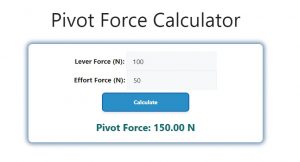About Pivot Force Calculator (Formula)
The Pivot Force Calculator is an essential tool in physics and engineering, helping to calculate the forces acting on a lever system. By understanding the dynamics of pivot points, lever forces, and effort forces, users can analyze mechanical systems more effectively. This calculator is particularly useful in applications such as construction, machinery design, and any scenario where levers are used to amplify force or motion.
Formula
The formula for calculating the Pivot Force is as follows:
Pivot Force = Lever Force + Effort Force
Where:
- Pivot Force = the total force exerted at the pivot point of the lever
- Lever Force = the force applied at the lever’s end
- Effort Force = the force applied to lift or move the load
How to Use
To effectively use the Pivot Force Calculator, follow these steps:
- Determine the Lever Force: Identify the force being applied at the end of the lever.
- Identify the Effort Force: Determine the force being exerted to lift or move the load.
- Insert Values into the Formula: Enter the values for Lever Force and Effort Force into the formula.
- Calculate: Perform the calculation to find the total Pivot Force.
- Analyze the Results: Use the calculated Pivot Force to understand the mechanics of your system better.
Example
Imagine a scenario where a lever is used to lift a load. The Lever Force is 100 N (Newtons) and the Effort Force is 50 N. To calculate the Pivot Force:
Pivot Force = Lever Force + Effort Force
Pivot Force = 100 N + 50 N
Pivot Force = 150 N
In this example, the total Pivot Force exerted at the pivot point is 150 N.

FAQs
- What is a Pivot Force Calculator?
A Pivot Force Calculator determines the total force at the pivot point in a lever system based on lever and effort forces. - Why is calculating pivot force important?
It helps engineers and designers understand how forces interact in mechanical systems, ensuring safety and efficiency. - What is the difference between Lever Force and Effort Force?
Lever Force is the force applied at the end of the lever, while Effort Force is the force used to lift or move a load. - Can I use this calculator for any type of lever?
Yes, the calculator applies to various lever types: first, second, and third-class levers. - How do I determine the Lever Force?
The Lever Force can be measured directly with a force gauge or calculated based on the load and lever arm length. - What factors influence Pivot Force?
Factors include the length of the lever arm, the amount of load, and the positioning of the pivot point. - How do I calculate the Lever Force?
Lever Force can be calculated using the formula: Lever Force = Load / Lever Arm Length. - Is there a maximum limit for Pivot Force?
The maximum pivot force is dependent on the material properties and design of the lever system. - Can I calculate Pivot Force for complex systems?
Yes, for complex systems, you may need to analyze multiple levers and their interactions. - What happens if I exceed the calculated Pivot Force?
Exceeding the calculated pivot force can lead to structural failure or malfunction of the lever system. - Can this calculator be used in real-life applications?
Absolutely! It is used in various fields, including engineering, construction, and robotics. - What is the significance of the pivot point?
The pivot point is the fulcrum around which the lever rotates, affecting the mechanical advantage. - How does changing the pivot point affect the force?
Moving the pivot point can change the lever’s mechanical advantage, impacting the required forces. - What tools can help measure these forces accurately?
Tools like force gauges, scales, and dynamometers can accurately measure the lever and effort forces. - Can I use this for weightlifting exercises?
Yes, the principles of pivot force apply to exercises using levers, like certain weightlifting movements. - How do I visualize pivot force in action?
You can create a simple model with a ruler, a pivot point, and weights to see how forces interact. - What are some common mistakes when calculating pivot force?
Common mistakes include miscalculating forces, ignoring friction, or not considering the lever arm lengths. - How can I ensure accurate results?
Double-check your measurements and calculations to ensure all values are accurate. - Are there online tools available for calculating pivot forces?
Yes, various online calculators can help streamline the process of calculating pivot forces. - What is the relationship between pivot force and mechanical advantage?
The mechanical advantage is the ratio of the load to the effort force, influencing how effectively a lever operates.
Conclusion
The Pivot Force Calculator is an invaluable resource for understanding the mechanics of levers and their applications in various fields. By accurately calculating the pivot force based on lever and effort forces, users can optimize their designs and ensure the effectiveness of their mechanical systems. With this knowledge, engineers and designers can create safer, more efficient products that meet their intended purposes.